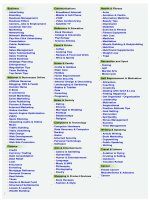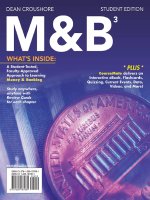Money and Banking: Lecture 14
Bạn đang xem bản rút gọn của tài liệu. Xem và tải ngay bản đầy đủ của tài liệu tại đây (1015.11 KB, 41 trang )
Money and
Banking
Lecture 14
McGrawHill/Irwin
Copyright © 2006 by The McGrawHill Companies, Inc. All rights reserved.
Review of the Previous Lecture
• Bond & Bond pricing
•
•
•
•
Zero Coupon Bond
Fixed Payment Loan
Coupon Bonds
Consols
• Bond Yield
• Yield to Maturity
• Current Yield
6-2
Topics under Discussion
•
•
•
•
•
•
Yield to Maturity
Current Yield
Holding Period Returns
Bond Supply & Demand
Factors affecting Bond Supply
Factors affecting Bond Demand
6-3
Yield To Maturity
• General Relationships
• If the yield to maturity equals the coupon rate,
the price of the bond is the same as its face
value.
• If the yield is greater than the coupon rate, the
price is lower;
• if the yield is below the coupon rate, the price
is greater
6-4
Yield To Maturity
• If you buy a bond at a price less than its face
value you will receive its interest and a capital
gain, which is the difference between the price
and the face value.
• As a result you have a higher return than the
coupon rate
• When the price is above the face value, the
bondholder incurs a capital loss and the
bond’s yield to maturity falls below its coupon
rate
6-5
6-6
Current Yield
• Current yield is a commonly used, easy-tocompute measure of the proceeds the
bondholder receives for making a loan
• It is the yearly coupon payment divided by the
price
Current Yield
Yearly Coupon Payment
Price Paid
6-7
Current Yield
• The current yield measures that part of the return
from buying the bond that arises solely from the
coupon payments;
• it ignores the capital gain or loss that arises when the
bond’s price differs from its face value
6-8
Current Yield
• Let’s return to 1-year 5% coupon bond
assuming that it is selling for $99.
• Current yield is 5/99 = 0.0505 or 5.05%
• YTM for this bond is calculated to be 6.06% through
the following calculations
$5
(1 i )
$100
= $99
(1 i )
• If you buy the bond for $99, one year later you get
not only the $5 coupon payment but also a
guaranteed $1 capital gain, totaling to $6
• Repeating this process for the bond selling for
$101, current yield is 4.95% and YTM is 3.96%
6-9
Current Yield
• The current yield moves inversely to the
price;
• If the price is above the face value, the current
yield falls below the coupon rate.
• When the price falls below the face value, the
current yield rises above the coupon rate.
• If the price and the face value are equal the
current yield and the coupon rate are equal.
6-10
Current Yield
• Since the yield to maturity takes account of
capital gains (and losses),
• when the bond price is less than its face value
the yield to maturity is higher than the current
yield,
• if the price is greater than face value, the yield
to maturity is lower than the current yield,
which is lower than the coupon rate
6-11
Relationship Between a Bond’s Price and
Its Coupon Rate, Current Yield and Yield to Maturity
Bond Price < Face Value:
Coupon Rate < Current Yield < Yield to Maturity
Bond Price = Face Value:
Coupon Rate = Current Yield = Yield to Maturity
Bond Price > Face Value:
Coupon Rate > Current Yield > Yield to Maturity
6-12
Holding Period Returns
• The investor’s return from holding a bond
need not be the coupon rate
• Most holders of long-term bonds plan to
sell them well before they mature, and
because the price of the bond may change
in the time since its purchase, the return
can differ from the yield to maturity
• The holding period return – the return to
holding a bond and selling it before
maturity.
6-13
Holding Period Returns
• The holding period return can differ from
the yield to maturity
• The longer the term of the bond, the
greater the price movements and
associated risk can be
6-14
Holding Period Returns
Examples:
• You pay for $100 for a 10-year 6% coupon
bond with a face value of $100,You intend
to hold the bond for one year, I.e.buy a 10
year bond and sell a 9 year bond an year
later
• If interest rate does not change your return will
be $6/100 = 0.06 = 6%
6-15
Holding Period Returns
• If interest rate falls to 5% over the year
then through using bond pricing formula
we can see that
• You bought a 10-year bond for $100 and sold
a 9-year bond for $107.11
• Now the one year holding return has two parts
• $6 coupon payment and
• $7.11 capital gain
6-16
Holding Period Returns
So now, one year holding Period return =
$6
$100
$107.11 $100
$100
$13.11
.1311
$100
or 13.11%
6-17
Holding Period Returns
If the interest rate in one year is 7%
One year holding Period return =
$6
$100
$93.48 $100
$100
$.52
$100
.0052
or -.52%
6-18
Holding Period Returns
• Generalizing, 1-year holding return is
Yearly Coupon Payment
Price Paid
Change in Price of the Bond
Price of the Bond
Current Yield Capital Gain (as a %)
6-19
Bond Market and Interest Rates
• To find out how bond prices are
determined and why they change we need
to look at the supply and demand in the
bond market.
• Let’s consider the market for existing
bonds at a particular time (the stock of
bonds) and consider prices and not interest
rates.
$100
$100 P Bond.
• One Year Zero-coupon
(discount)
P
or i
1 i
P
6-20
Bond Supply, Demand and
Equilibrium
Bond Supply
• The Bond supply curve is the relationship
between the price and the quantity of
bonds people are willing to sell, all other
things being equal.
6-21
Bond Supply, Demand and
Equilibrium
Bond Supply
• From the point of view of investors, the
higher the price, the more tempting it is
to sell a bond they currently hold.
• From the point of view of companies
seeking finance for new projects, the
higher the price at which they can sell
bonds, the more advantageous it is to do
so.
6-22
Bond Supply, Demand and
Equilibrium
Bond Supply
For a $100 one-year zero-coupon bond,
the supply will be higher at $95 than it will
be at $90, all other things being equal.
6-23
Bond Supply, Demand and
Equilibrium
Bond Demand
• The bond demand curve is the relationship
between the price and quantity of bonds
that investors demand, all other things
being equal.
• As the price falls, the reward for holding
the bond rises, so the demand goes up
6-24
Bond Supply, Demand and
Equilibrium
Bond Demand
• The lower the price potential bondholders must
pay for a fixed-dollar payment on a future date,
the more likely they are to buy a bond
• The zero-coupon bond promising to pay $100 in
one year will be more attractive at $90 than it will
at $95, all other things being equal.
6-25









